Design
Looking for inspiration, design tricks, how to make a great cover, promoting your yearbook and engaging your community?
Most recent
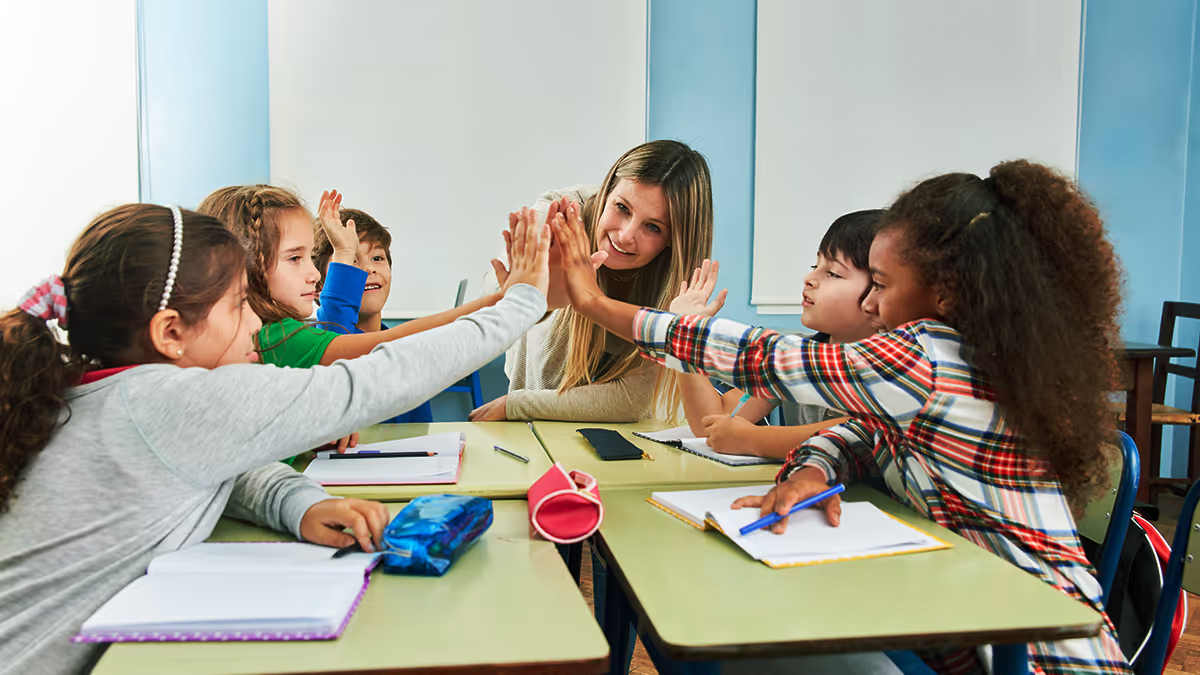
Anatomy of an elementary school yearbook
This is the time of year when all those shared photo folders are filling and your spreads are mostly blank. It’s time to build the book. And if you don’t know where to start, check out a sample yearbook ladder to see how one of our Treering schools organizes its book.
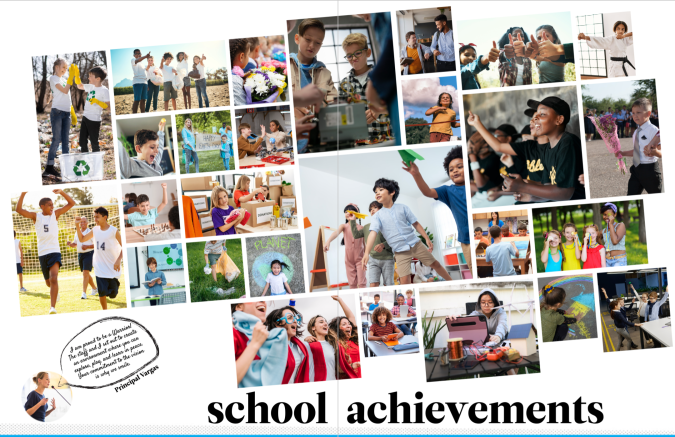
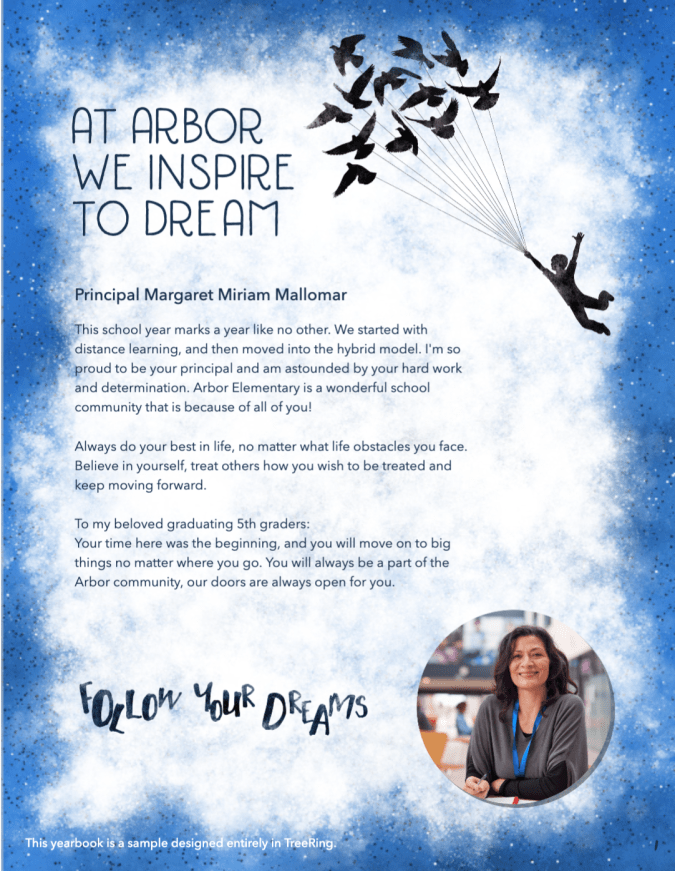
Principal’s Letter
Some of the best advice I ever received on principal letters came from a veteran adviser: “Connect to the theme.” The yearbook theme serves as the unifier between all the clubs, activities, sports, and classes that take place throughout the year. So it makes sense that, as the leader of the school, the principal’s message both unifies and sets the stage for that theme. Incorporating the theme is a way to also recognize the hard work of your yearbook team and a subtle show of support.
When meeting with your principal, communicate:
- The desired length
- Any talking points your want him/her to address
- Deadline (really, you want to give roughly two weeks)
Depending on your relationship with your principal, you may be able to present a first draft for him/her to finesse. Generally speaking, the principal’s letter appears at the opening or closing of the book or in the staff section.
Classroom Photos
Photographs of students working in the classroom give a true portrait of their day. (Lame pun intended.) American students spend roughly a quarter of their day in school. Let’s showcase their contributions and celebrate their achievements.
Elementary School Events
Fundraisers, dances, parades–oh my! These all-school events showcasing your student body's unity are must-haves for your yearbook, as are the class distinctions: 5th/6th grade trip, 100th Day of school, faculty vs. parents soccer game, reading buddies, etc.
Don’t feel like you have to devote a double-page spread to each! One spread can feature all the class parties, and another the fundraisers.
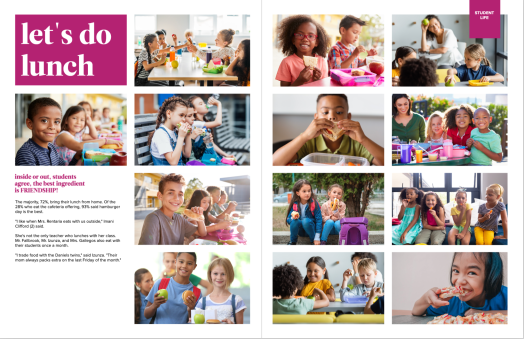
Candids/Lunch
Just as the academics photos are valuable, so are the in-between moments when students are at lunch or during transition periods. Playgrounds and lunchrooms are daily photos ops for volunteers and teachers to snap these carefree moments. You may want to include photo collages between grades (i.e. upper and lower school recess and lunch) or as the perimeter for autograph pages.
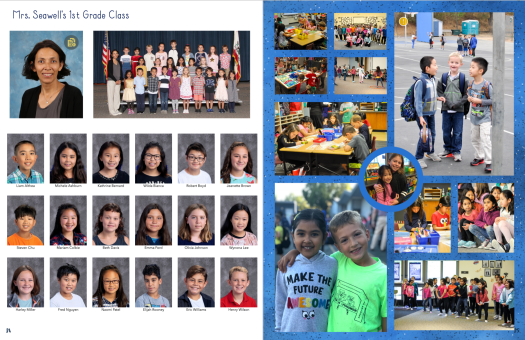
Portraits
Much of your elementary school yearbook will be portraits–these tend to take up an average of 40% of the book! You can organize these:
- By grade and feature some fun facts about each group (e.g. miles run at the Jogathon)
- By grade and teacher with classroom candids sprinkled in
Heads up: this is where you want to be extra diligent with your proofreading strategy. We suggest handing out your PDF proofs to each teacher to approve or hanging them in a conspicuous place to make sure names and classes are correct.
Extra Ideas for Your Elementary School Yearbook
Table of Contents
In an elementary school book of 20 pages, will you need a table of contents? Probably not. If you want to help guide your readers, add a small one to your title page. Larger books should divide themselves into sections. A table of contents is a great place to drop in some extra photos of students.
Special Recognition for Promoting Students
Parents love bragging about their children. (Present company included!) If they are not adding copious custom pages, they may appreciate the opportunity for a recognition ad. You'll appreciate the opportunity to raise some additional funds for your program.
Because you know your elementary school community best, you know what they will want in the yearbook. We're here to help!
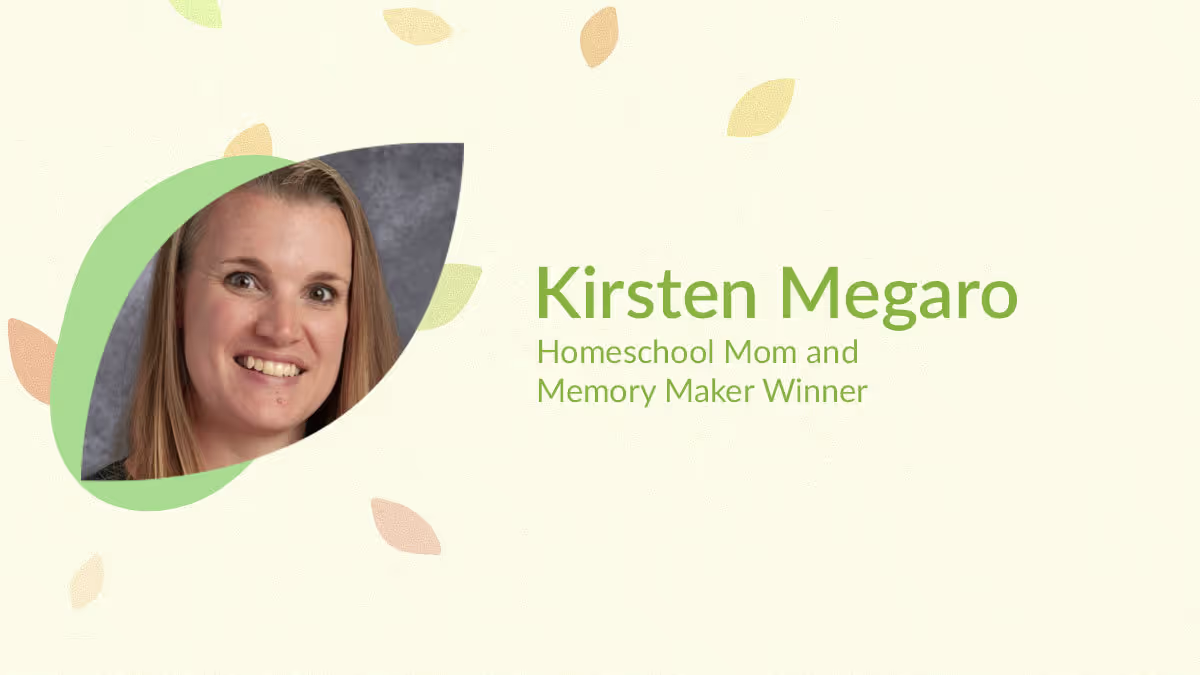
Yearbook hero Kirsten Megaro tells a complete story
Treering Yearbook Heroes is a monthly feature focusing on yearbook tips and tricks.
In our first-ever parent contest, Treering Yearbooks asked parents to capture and share their child’s unique POV. Homeschool mom Kirsten Megaro from Netcong, NJ created a spread to celebrate the growth in all areas of her three kids' lives: educational accomplishments, deepening friendships and family relationships, creative projects, and current hobbies and activities.
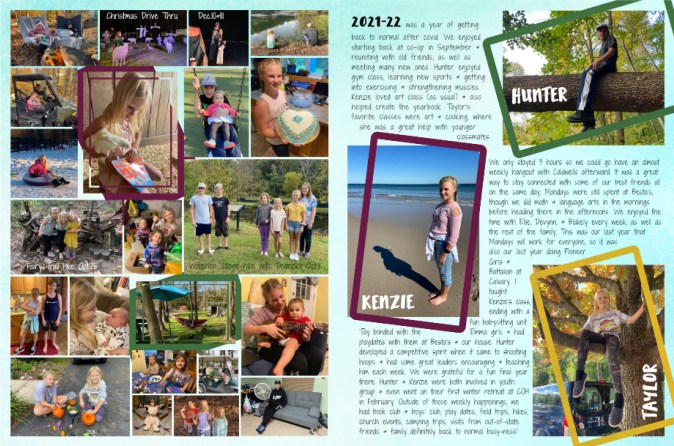
How did you decide what to include on your custom pages?
Our homeschool co-op offers a mix of core and extracurricular classes. We love how our yearbook documents the classes and field trips we enjoy with our group each year. The custom pages allow us to see a wider view of our year.
I like to include a casual portrait of each kid from the year as a focal point, then use larger text boxes to give an overview of the main activities we participated in during the year. I fill in the rest of the spread with some of our favorite photos with captions to share the accomplishments they had, hobbies they pursued, important people in our lives, and field trips we took throughout the year.
The judges loved the color scheme as well as the repeating elements of the rounded rectangles.
I love playing around with layout: moving pictures, adding frames, making it organized, but just a little quirky too.
How do your kids help tell their stories?
We take so many pictures that it’s hard to narrow them down. I usually start by choosing my favorites that give a good overview of our year, then ask my kids what information and pictures they want to include to remember for the future.
What advice would you give to another parent who is just getting started?
Start simple: use a template for your layout—there are a lot of great options! Drop your pictures in and add a few captions. Add a creative touch here or there to start, and each year, you’ll get more and more confident and capable of showing your personality and style through your pages.
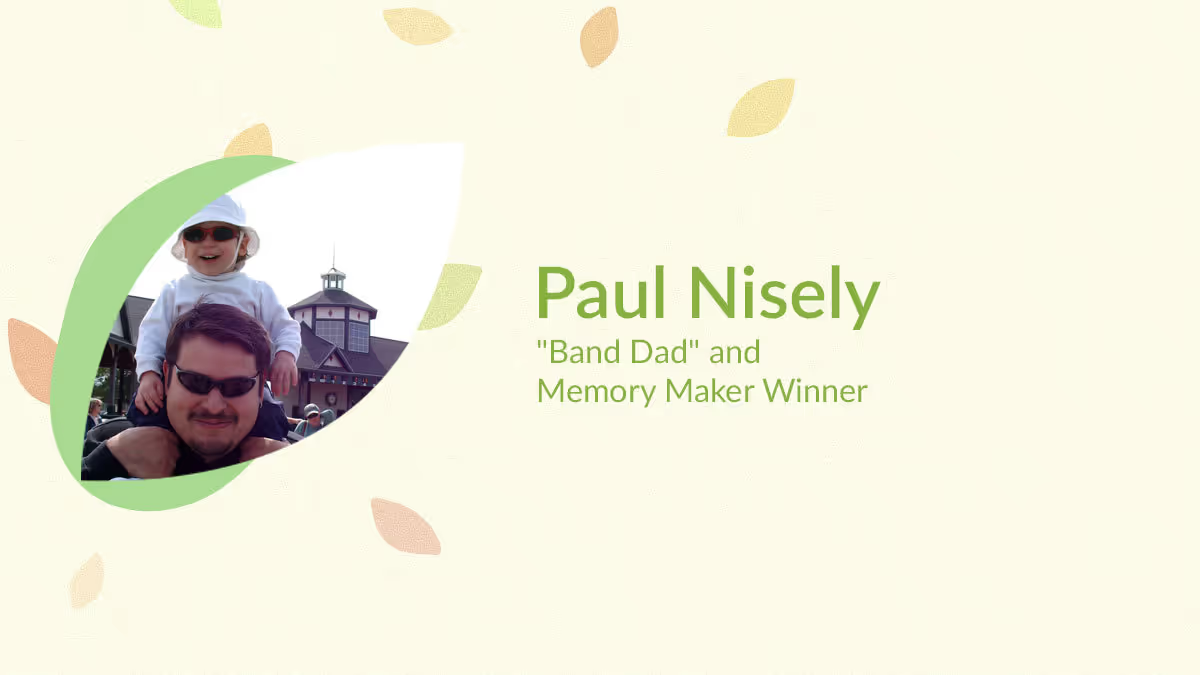
Yearbook hero Paul Nisely made us cry
Treering Yearbook Heroes is a monthly feature focusing on yearbook tips and tricks.
In our first-ever parent contest, Treering Yearbooks asked parents to capture and share their child’s unique POV. Self-described Band Dad Paul Nisely from Charlotte, NC entered the senior tribute he created for his son, Jason.
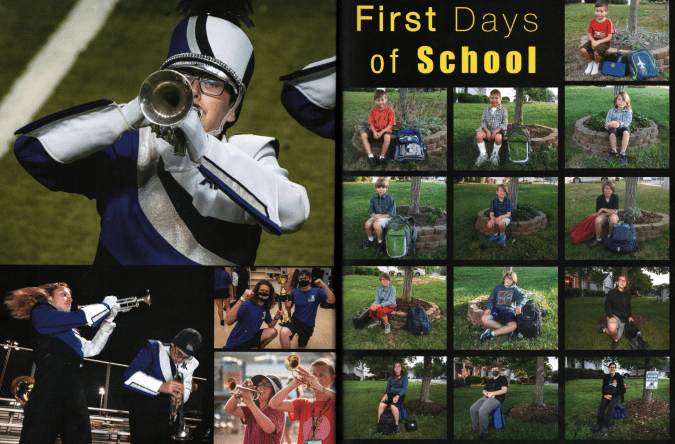
Paul featured his son’s involvement as a trumpet player in both the marching band and the school’s band as well as the friendships he’s built and maintained throughout 9-12 grade. On the right-facing page, he created the show-stopper that had us all choked up.
How did you decide what to include on your custom pages?
I have been taking a first day of school photo of my son in the same spot in front of our house every year since kindergarten and wanted those memories on one page. I have seen this done many times before.
In addition to seeing the changes in your child, you can also see the changes in the background scenery. We had to remove the brick edging because it was a fire ant nest which we realized after a photo. The different hairstyles, clothes, and backpacks show how much he has changed and how quickly the years go by. Every time I look at that page it makes me tear up.
Paul, let me tell you, there was a lot of emotion from the parents on the panel after seeing your spread. A reverent hush permeated the meeting, and then we read your story.
I love telling a story and getting emotional reactions with my photos. I was a newspaper photographer and went to school for photography and absolutely love seeing “visual moments” and documenting them. When the marching band season is finished I love putting together the photo book for that season. Even though my son is graduating I have already told the band directors I would love to keep taking photos of the band and making more keepsake photo books for the kids and their families.
Since you’re also a professional photographer, will you share some tips?
Take a lot of photos! You can’t run out of film: it's all digital now. Be there for the moments that are important for your child and capture them. Be patient with your child and be patient when taking photos. Then tell a story with those photos.
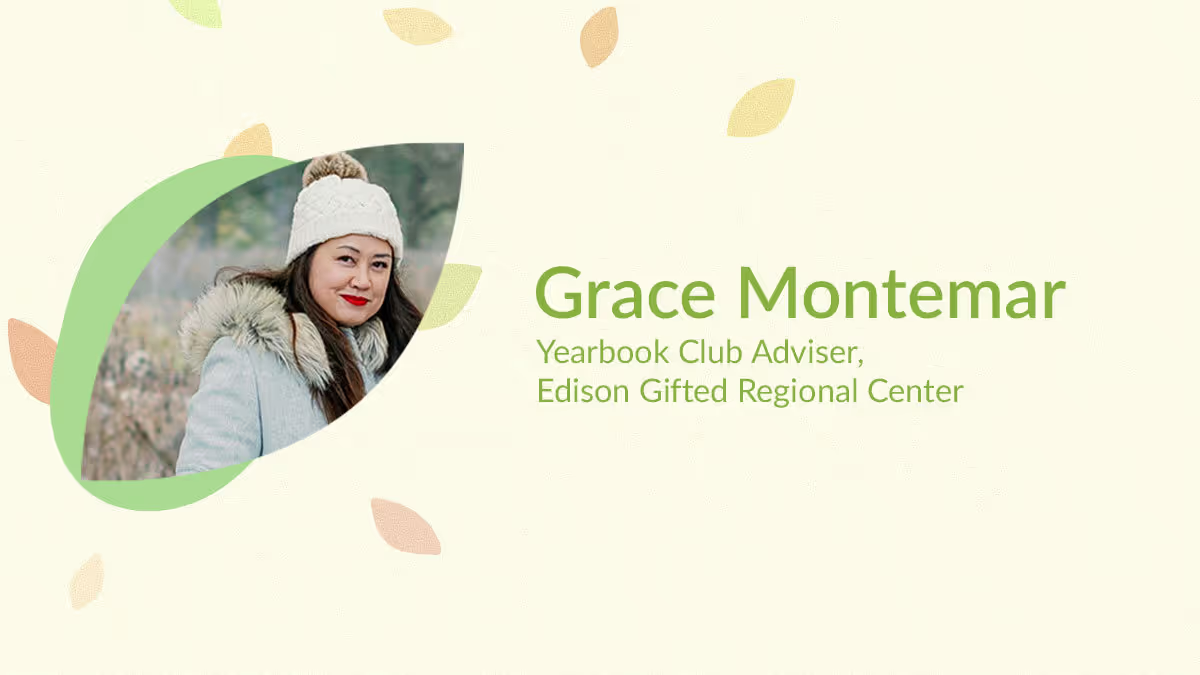
Yearbook hero Grace Montemar's show-stopping design
Treering Yearbook Heroes is a monthly feature focusing on yearbook tips and tricks.
In March, Treering Yearbooks announced its 2022 #TreeringMemoriesMatter Design Contest for yearbook advisers, coordinators, and editors to share their unique perspectives from their campus community. It’s time to meet the winners and glean their best practices for yearbook spread design.
Grace Montemar is the Yearbook Club Adviser from Edison Regional Gifted Center in Chicago, IL. Her team earned first place in the middle school division for their “Aesthetic” spread. The reporting and design distinguished this spread.
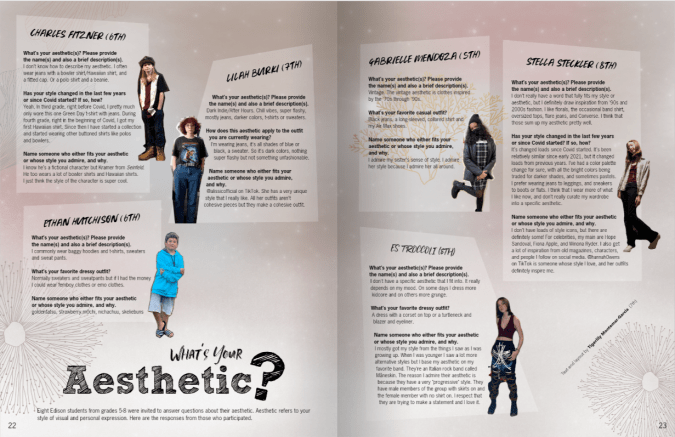
Tell us about this show-stopper.
While we like to include several recurring spreads that appear in our school’s yearbook each year, we still like to introduce a few new features as well. This fresh feature allowed Yearbook Club to spotlight classmates from various grades whose fashion sense stood out from the crowd. The students who were invited to participate enjoyed answering a brief questionnaire that helped to illustrate their distinctive style.
How does Edison RGC design the book?
I typically like starting with a general template but then customizing it to suit the needs of the specific spread. Some of my yearbook students prefer creating a layout from scratch, which takes much longer. But if they’re committed to doing it this way (and time allows for it), then it’s totally fine.
I also try to manage expectations upfront so they understand that there will usually be a lot of polishing involved before their spread is fully ready for publishing in the yearbook. One thing that my yearbook students love is seeing their names attached to their work. It gives them a sense of pride to see their byline displaying their name and grade on any spreads that they’re involved in.
What does your role look like as a club adviser?
My responsibilities include recruiting and training the 6th-8th graders who join Yearbook Club, running the weekly meetings, empowering the students to help build the ladder and decide content, art directing them in designing their layouts, and helping them to proofread, edit, and write copy.
I also handle the marketing aspects––sending announcements to key channels for sharing with the intent of promoting sales with parents, as well as encouraging photo submissions.
How do you gather photos?
Pre-pandemic, the majority of photos were taken by myself, and/or I recruited parents who had an eye for photography to cover events that I couldn’t attend. With in-person events slowly starting to happen this school year, I’ve been able to resume taking some photos but we’re still relying more on community submissions than we have in past years. In order to keep the submissions coming, we periodically request specific photos throughout the year (to avoid receiving an onslaught of images too late in the production timeline).
What advice would you give to another person who is just getting started?
Congrats on accepting your role with the yearbook! It can feel overwhelming to take on this endeavor but you’ll do just fine. Here are some tips to help you:
- Take things one step at a time––but don’t wait. If you work on the yearbook little by little, regularly, and continuously, it’ll be much easier to produce, as opposed to cramming and rushing everything all at once at the end.
- Ask for help from your community when you need it. Need more photo submissions? Be sure to ask for help from the room parents and PTO in spreading the word. Still trying to recruit students? Ask for help from the principal or certain teachers in drumming up interest. You’d be surprised who’s willing to help (and how) if you just ask.
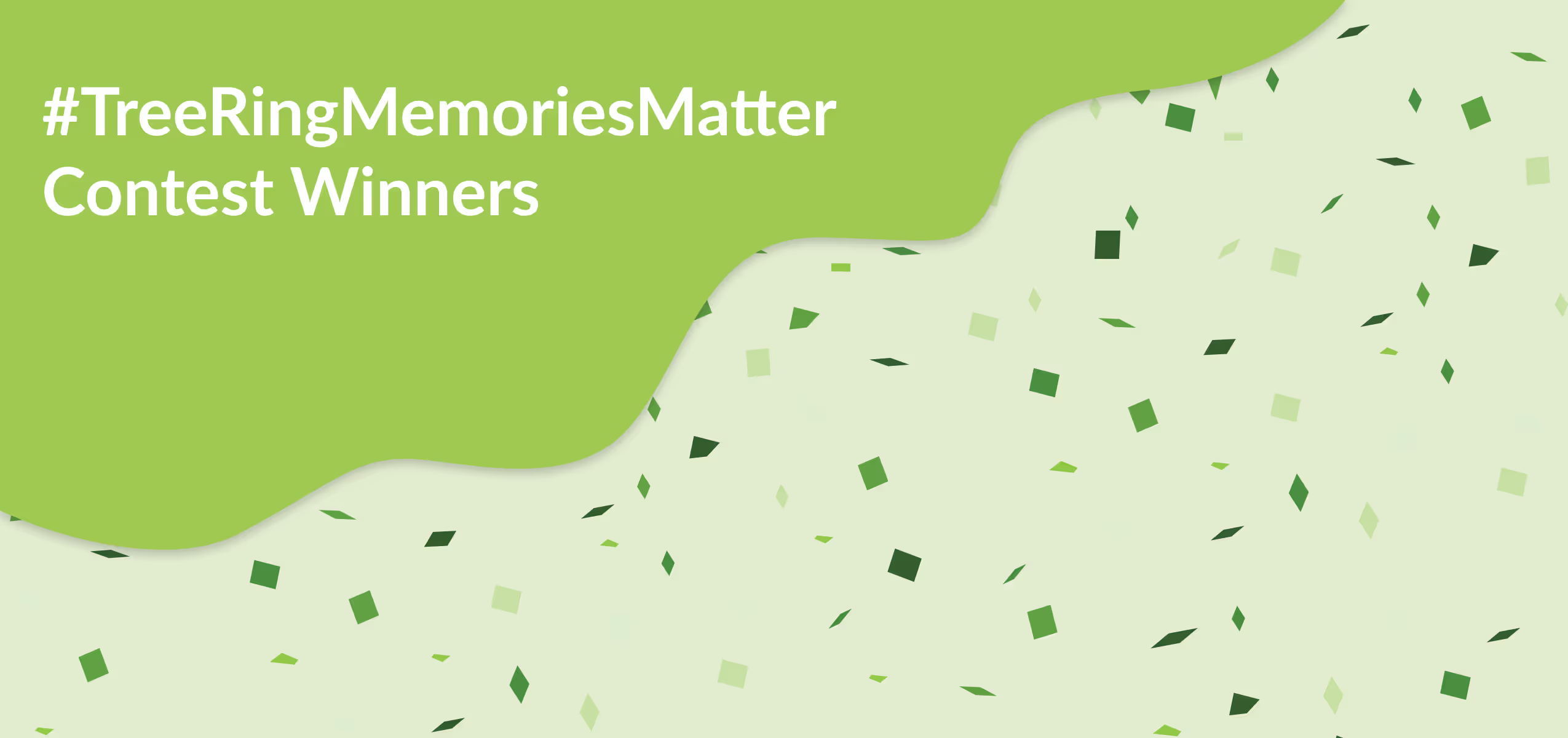
Winners of the 2022 #treeringmemoriesmatter contest
Treering Yearbooks is pleased to announce the winners of our 2022 #TreeringMemoriesMatter Design Contest. Yearbook editors from across the US submitted their favorite yearbook spreads from the 2021-2022 school year.
First Place Winners
Elementary School: Del Norte Heights Elementary School, El Paso, TX
The blended coverage of a teacher-organized remembrance ceremony of 9/11's 20th anniversary and a celebration of one of America's most popular children's books captured the "return to normalcy," Yearbook Coordinator, Elyse Hernandez said.
The Del Norte Team earned second place in our 2021 contest with their spread on face mask fashion.
"As we returned to our classrooms in person, students embraced the return to normalcy, and being able to create traditions and celebrate our students is one of the many facets that make Del Norte Heights an amazing learning center," Hernandez said. "That is why our Treering Memories really matter!"
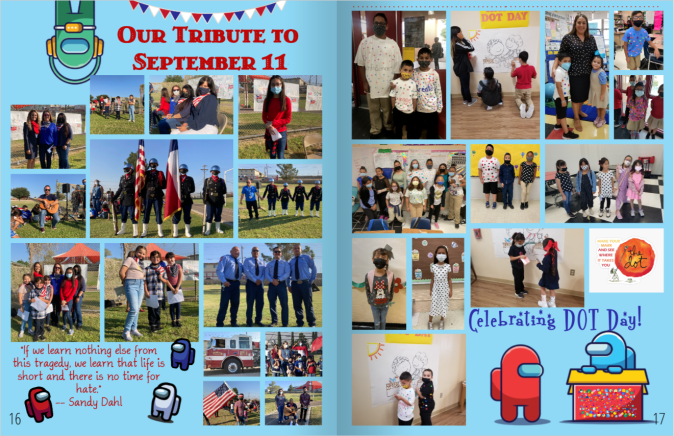
Middle School: Edison Regional Gifted Center, Chicago, IL
This show-stopper spread is a strong example of inclusivity and trends (hello botanical design and pop culture). Notice how each student has individualized interview questions. We also love that the cutouts aren't true COBs, which adds to the magazine feel.

High School: Grandview High School, Grandview, WA
Student editor Jazmine Richey created this spread which incorporates both theme elements and the here-and-now of the campus: a state-tournament appearance, the return of fans in the stands, and a new building. We love the modular look.
"The [red] line represents not only the presence of the Red Line of Equity in our everyday lives but the beginning of the creation of traditions here at GHS," Lilly Kassinger, the student who nominated Richey's work, said.
And the QR code? It links to a highlight reel of the season.
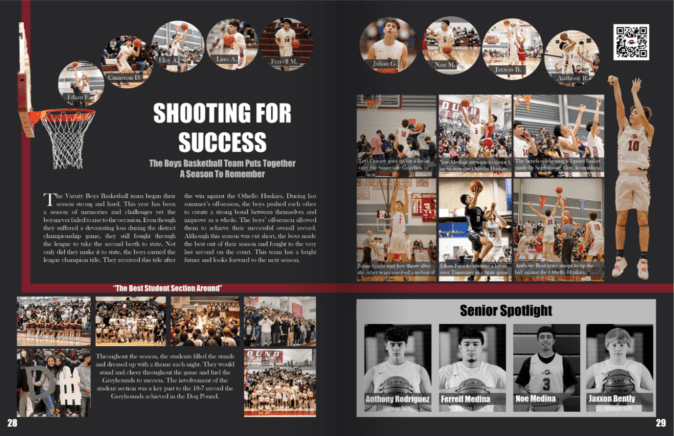
Each of the first-place winners will share their tips and tricks in upcoming blogs.
Second Place Winners
Elementary School: Lois Lenski Elementary, Littleton, CO

Middle School: Lennox Middle School, Inglewood, CA
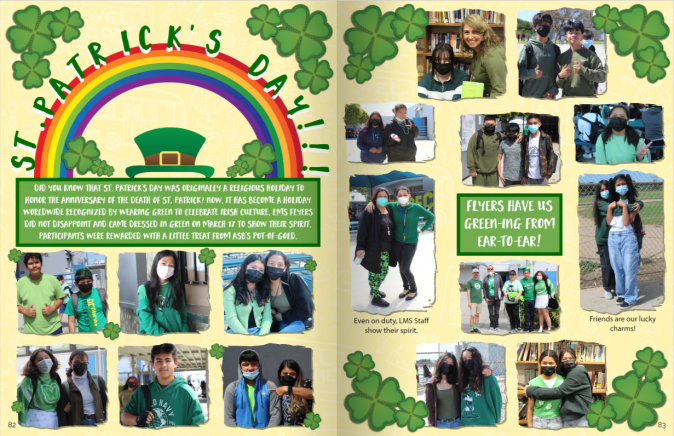
High School: Pennyroyal Area Christian Home Educators of Kentucky (PACHEK), Hopkinsville, KY
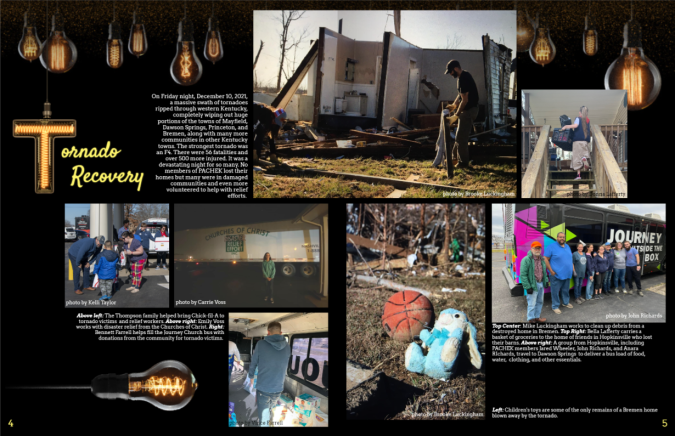
Third Place Winners
Elementary School: Orion Alternative and Mandarin Immersion, Redwood City, CA
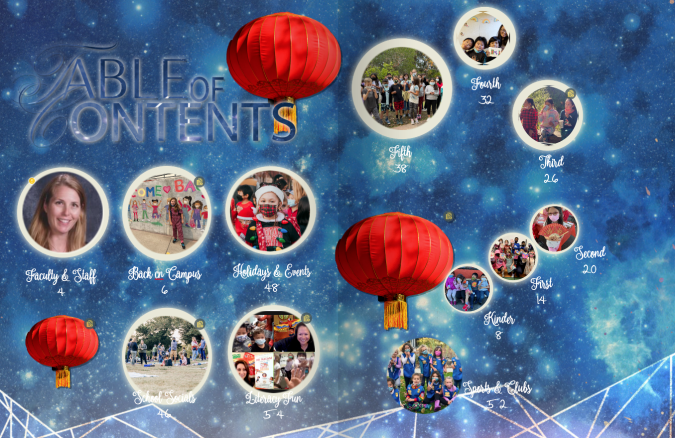
Middle School: Mountain School, Soquel, CA
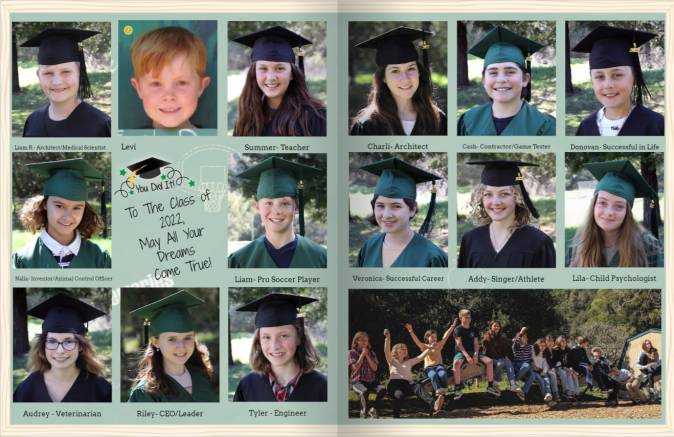
High School: Freedom High Magnet School, Albuquerque, NM
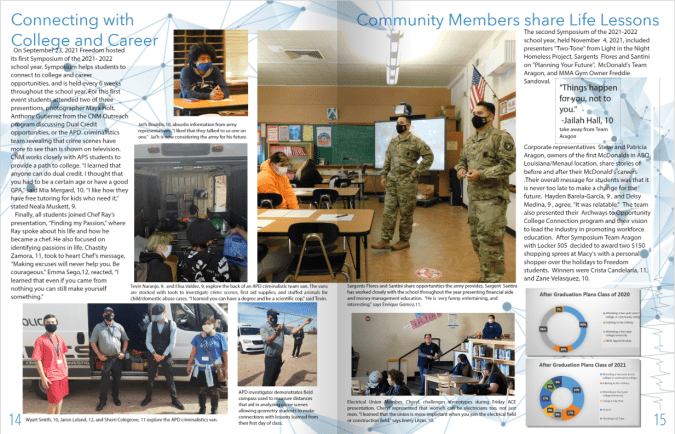
QR Code is a registered trademark of DENSO WAVE INCORPORATED.
2022 #TreeringMemoriesMatter Runners Up
Abington Friends School
Ardrey Kell Band Booster
Blue Ridge Academy
Bremerton High School
Cetronia Elementary School
Chateauguay Valley Regional
Chester W. Morrison Elementary
Christ Lutheran
Evergreen Valley High School
Gregory-Portland High School
Lakeside Christian School
Lyman High School
New Traditions
North Elementary School
Okaloosa Stem Academy
Orange County Classical Academy
Perry Lecompton Middle School
Premont I.S.D./Premont Collegiate High School/Premont Early College Academy
Presidio Middle School
Sky Ranch Middle
Southeast Academy High School
St. Cloud Christian school
St. Xavier Catholic School
The Learning Connection (TLC)
Thomas Rivera Elementary
Villagers
Virginia's Governor's School for the Arts
The judges, a panel of yearbook professionals, graphic designers, parents, and journalism educators, thank everyone who entered the 2022 #TreeringMemoriesMatter Design Contest.

Three yearbook colophon ideas
What is a colophon anyway? Publishers include this vital piece to record production notes and sometimes acknowledgments. Since your yearbook is a historical document, including a colophon adds professionalism to your publication. But it doesn’t have to be boring! Below are three examples of yearbook colophons that include theme details, shout-outs, and yearbook staffing information.
Essential Components for Your Yearbook Colophon
- Title of yearbook and theme information: include any behind the design information
- Book details: the number of pages, cover type, and paper weight
- Design specs: font names sizes and use cases
- Photography credits: Identify your portrait photographer, staff photographers, and any volunteer super parents who contributed
- Software tools: list which applications you used to build your book
- Publisher information: name of the publisher and the names of the publishing staff who helped
Thematic Colophons
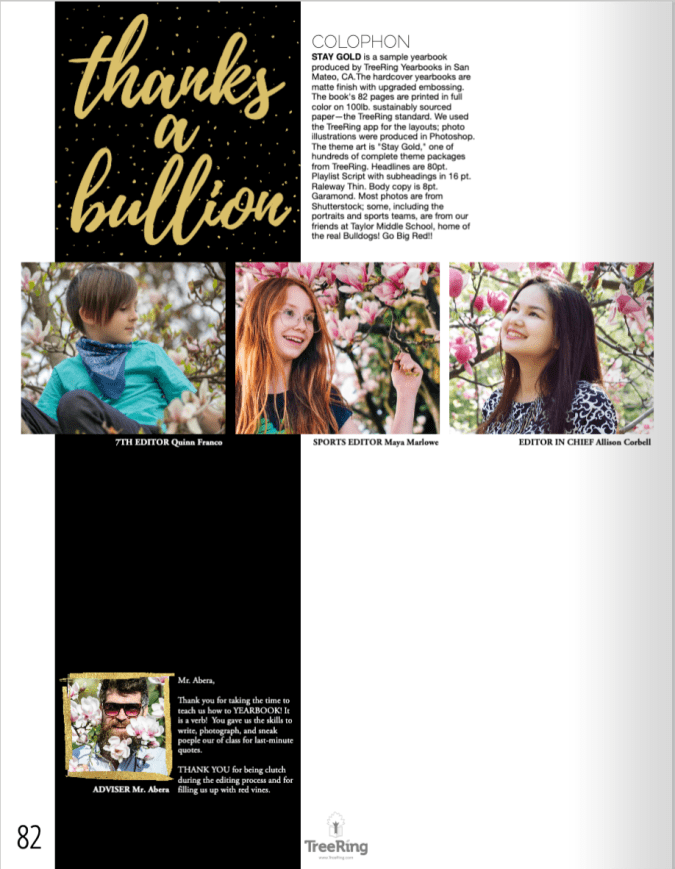
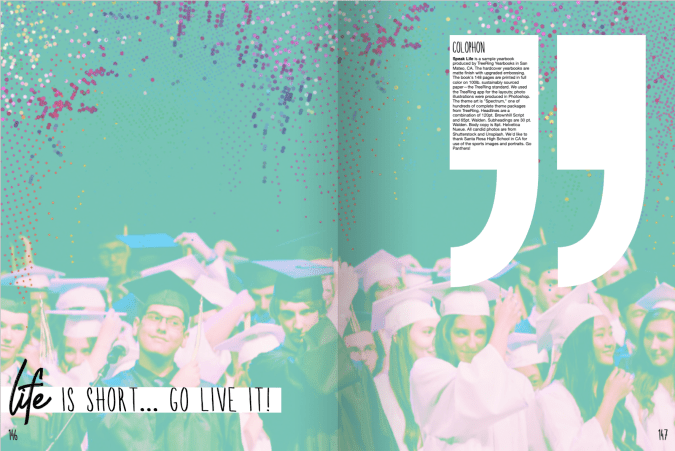
Both of these colophons leverage their themes (Stay Gold and Speak Life, respectively) with the headlines as well as the graphics. (The actual copy of their colophons is below for you to use.)
A Bold Colophon
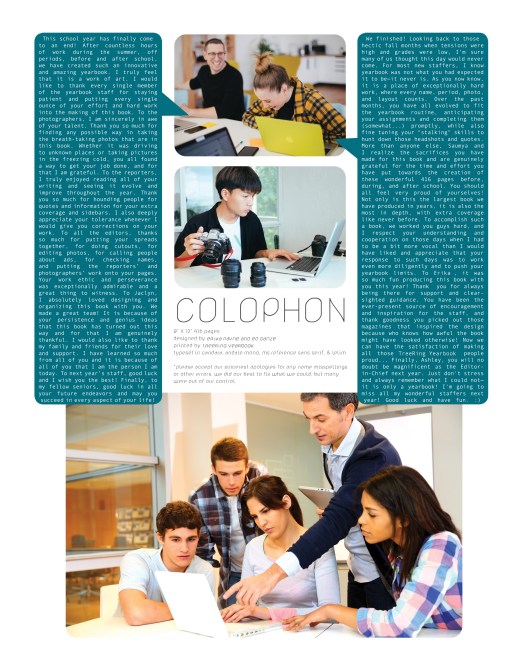
We love this one because it features the yearbook team, gives the book details in an easy-to-read format, and both editors have space to say thank you.
Yearbook Colophon Template
To create a quick colophon, copy and paste the following in your yearbook. Make it your own by giving behind-the-design details.
[Yearbook name] is produced by [School Name] in [City, State] and published by Treering Yearbooks in San Mateo, CA. The [hard- and/or softcover] yearbooks are [matte or glossy] finish [with upgraded embossing or foil]. The book's [number] pages are printed in full color on 100lb. sustainably sourced paper—the Treering standard. We used the Treering app for the layouts; [if applicable, list software used to make photo illustrations]. The theme art is [theme name from Treering] and [name] designed the cover. Headlines are [font and size] with subheadings in [font and size]. Body copy is [font and size]. [Photographer] took the school portraits and [parents, coaches, non-yearbook students] contributed [team, event, and/or candid] photos.
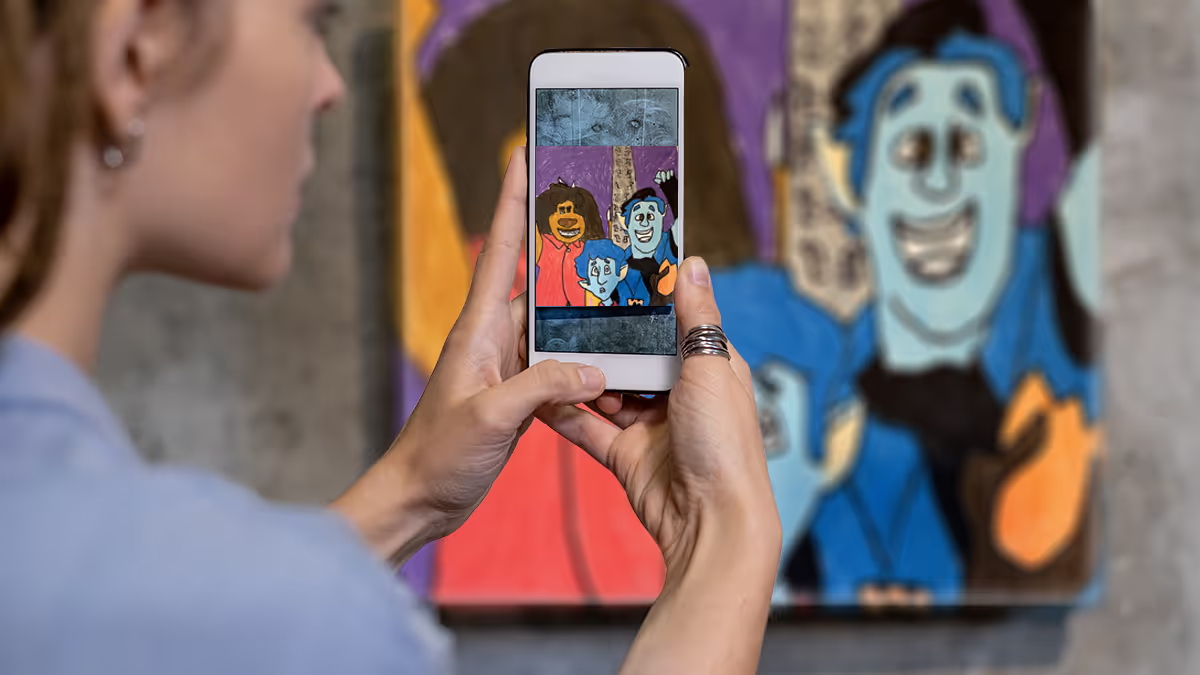
What should I do with all my child's art?
Dear Mama, you're not alone. Many of us look at the creations in our children’s portfolio and think, “Now what?” The fridge is covered. The more ambitious among us swap out art in frames, while others load up bin after bin (or just chuck it in the bin). We have an art display idea to help you preserve your child's memories.
How to Photograph Your Child’s Art
The number one rule in photography applies here: get your lighting right! Eliminate shadows and flares by having multiple points of lighting. Natural lighting by a window is best.
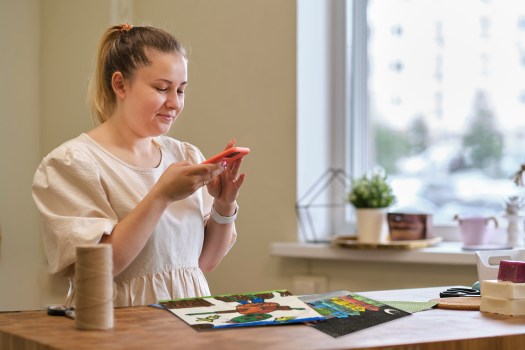
Second, you’re going to want to make sure your camera angle is congruent to your art. (See, that high school geometry class has real world application!) This gets rid of distortion. You can make slight adjustments using your camera app.
Personalized Pages
Now that your child’s art is digitized, do something with it!
Since every Treering yearbook comes with two, free personalized pages that print only in your yearbook, you can create a mini-gallery to display paintings, sculptures, and sketches without giving away more real estate in your home. (You can also add more pages for homework, family vacations, and events.)
Fast forward to high school graduation: all your yearbooks are lined up and you can show off your child's progression in penmanship, Scouting, or science fair.
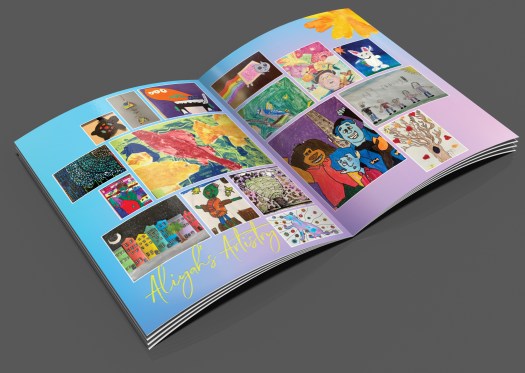
Instead of suffering from mom guilt, you can display your child's year in art forever.
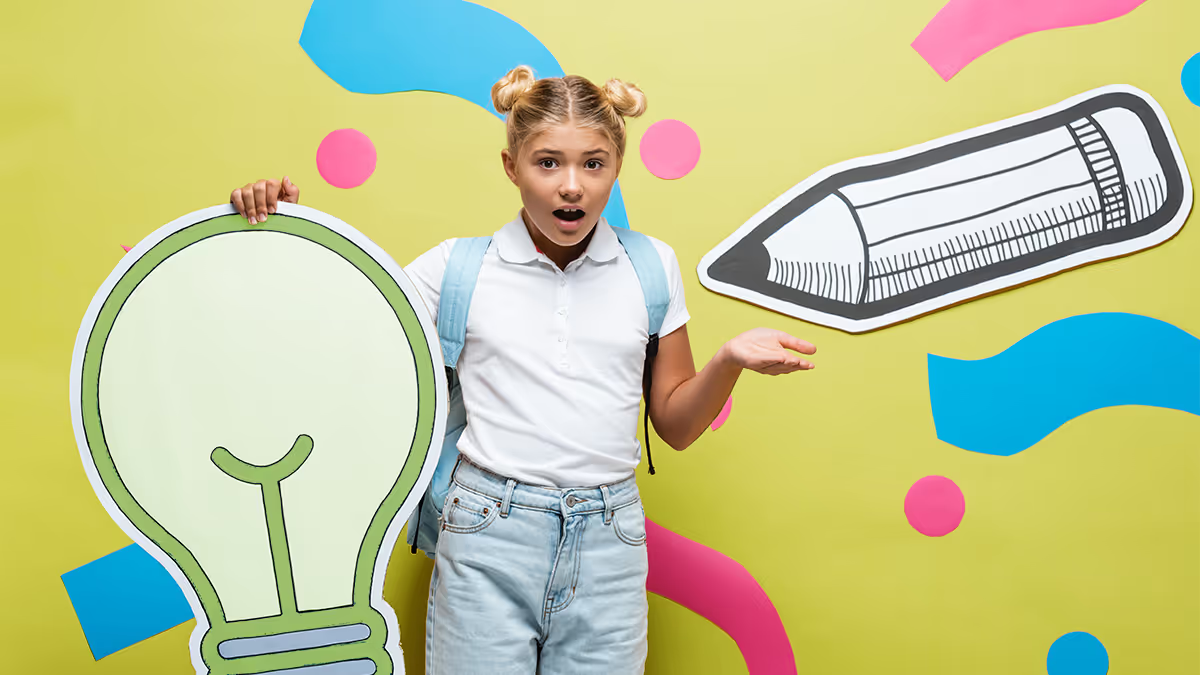
3 (but really 7) design elements to up your yearbook's visual appeal
Personal anecdote: In 1996, I joined my first yearbook staff. Shout out to Mr. Wayne Weightman who took a chance on a loud introvert and turned her into a creator. Fast forward a quarter-century (sheesh) and his yearbook design lessons are still impacting students—some of whom are now educators—and scores of creators.
The Easiest Element: Spacing
One pica was the standard back in the day when orange wax pencils and cropping squares were the norms. Each spread was designed on grid paper measured in picas. Below is an example of one pica standard yearbook spacing. It's clean. It's traditional. It's fine.
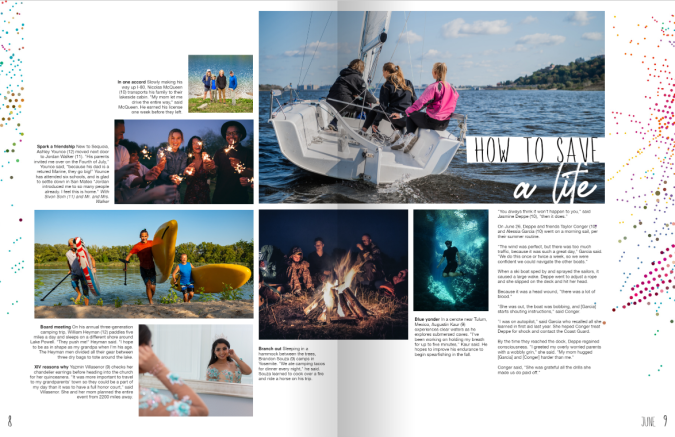
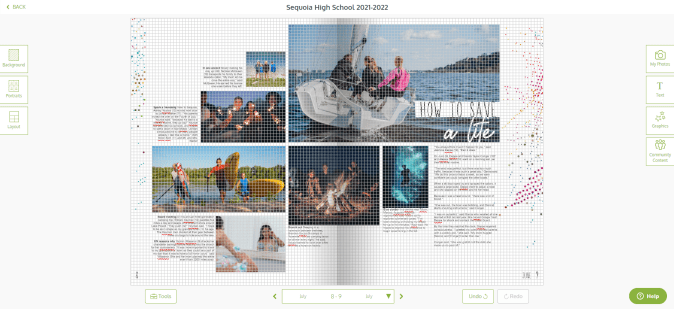
Contrast that with tight spacing. This is one-half pica (the design equivalent of red stilettos). Your spread just had a glow up.
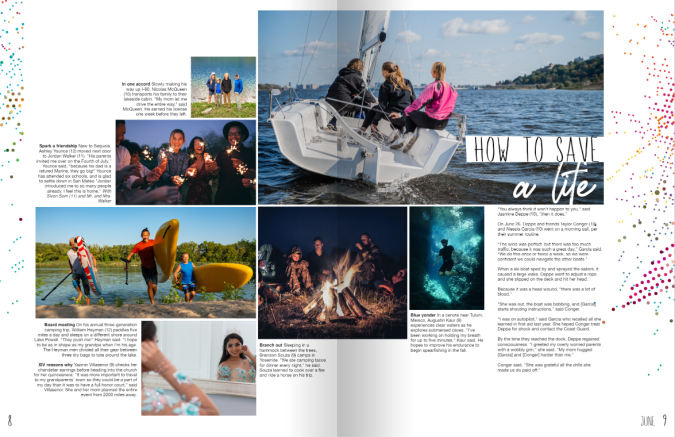
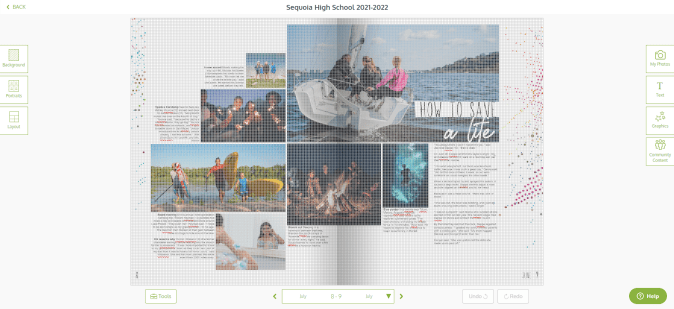
The Dominant Element: Hierarchy in Yearbook Design
Hierarchy tells our buyers what’s important, and for all you ELA teachers, it’s the outline of the spread. Spoiler alert: size matters.
The yearbook design lesson here is to immediately attract your reader’s attention with a dominant image or module. Use the golden spiral to build off your dominant. Use this ready-made yearbook design lesson to help launch your discussion with your students.
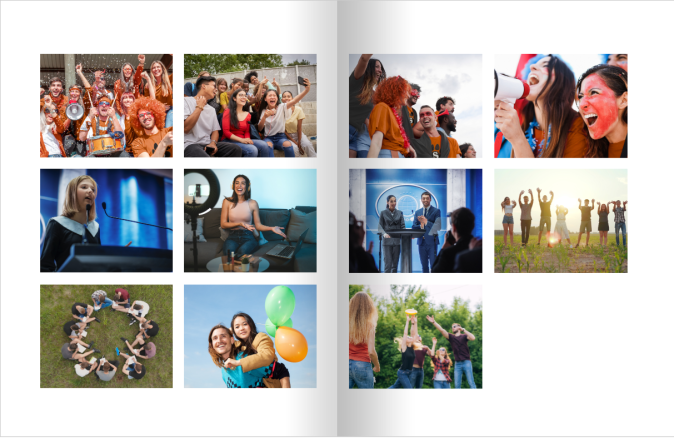

1. Photographs
The most interesting, story-telling, awe-inspiring photo should be dominant on your spread. Connect your headline to this image. You can build off your dominant photograph to fill your spread.
2. Headline
Advertising genius David Ogilvy said, “On the average, five times as many people read the headline as read the body copy. When you have written your headline, you have spent eighty cents out of your dollar.”
Since a headline is our entry point, it should connect yearbook buyers with the focus of the spread. Avoid “Football” when every photo pictures football–your buyers are smarter than that. If you must spell it out, use the folio. Appropriate puns, alliteration, and rhymes are literary techniques to use.
3. Body copy
My yearbook students once tried to 86 captions because “no one reads them.” Another Mr. Weightman yearbook lesson: “If they were worth reading, people would.” Ouch. (And true.)
Lessons centered around the art of open-ended questions made interviewing more of a conversation. Students would develop 10 questions and always end the interview with “Is there anything else I could have asked?”
Oh, and in case you’re wondering, people did read those captions.
If you’re just getting started, practice using anecdotal quotes to fill in captions and add detail. Captions should include facts and sensory details while identifying the subject of the photograph and their grade. More writing lessons abound in the Treering Yearbooks’ free curriculum.
The Fun Elements: the Acronym You and Your Students will Never Forget
Shout out to another design influencer: Robin Williams (not the genie). She’s a proponent of contrast, repetition, alignment, and proximity—master these four things, and everything you touch will be design gold. (I’ll give you one second more to figure out the acronym.) Teach these design elements individually, then combine them for the ultimate yearbook design lesson.
Contrast
Pair a bold font with a condensed one. Use opposite sides of the color wheel. Get crazy with font size (within reason). These design elements teach your reader where to look, and when used in concert with hierarchy, tell your students’ stories in an easy-to-follow manner.
Other ways to create contrast include shape (horizontal vs. vertical) and weight (thick vs. thin).
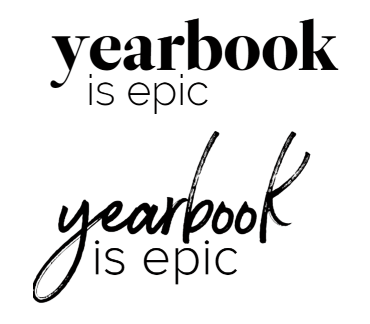
Repetition
From cover to cover, your book should look cohesive. Every layout will not be the same. I repeat, every layout does not have to be the same! Colors, fonts, sizes, and design elements should be consistent throughout your book. Remember, your theme is the brand, and your book is the platform by which you will develop it.
Alignment
Design is intentional. On your yearbook spreads, align
- Copy
- Photographs
- Quote packages
Proximity
Put the things that go together, together. This seems like a no-brainer, and yet, it’s a yearbook design lesson worth refreshing year after year.
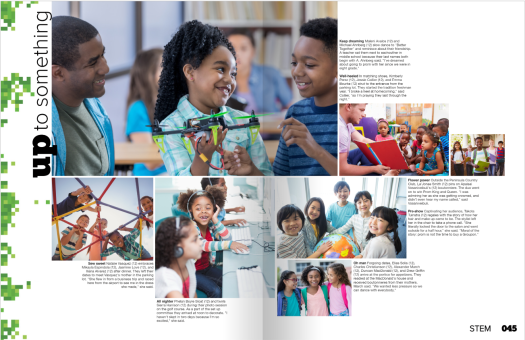
Yearbook design lessons are something you can teach throughout the year. Pin your favorite ideas (or steal some of ours).
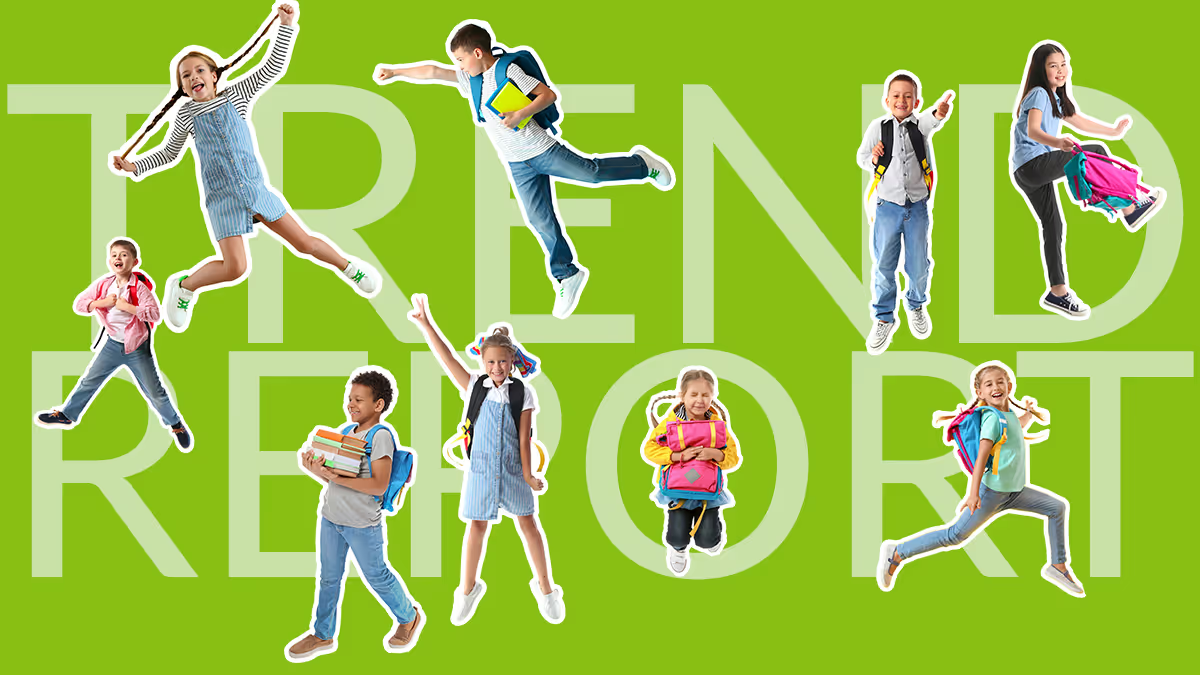
Year-end trend report
This is the time we often find ourselves reflecting on moments or trends that defined the year: countdowns dominate TV and radio, your Insta feed is filled with top nine collages, and influencers hype up-and-coming trends. Because the yearbook has the potential to be a campus influencer, below are just a couple of things to consider documenting in yours so students can look back and reminisce. It's easy to add trends and events that defined the year in the definitive archive of academia: your yearbook.
Current events
Add a trend timeline or spread so students can remember historic events, recall how most students chose to tuck in their t-shirts, or laugh at the social media craze during that time.
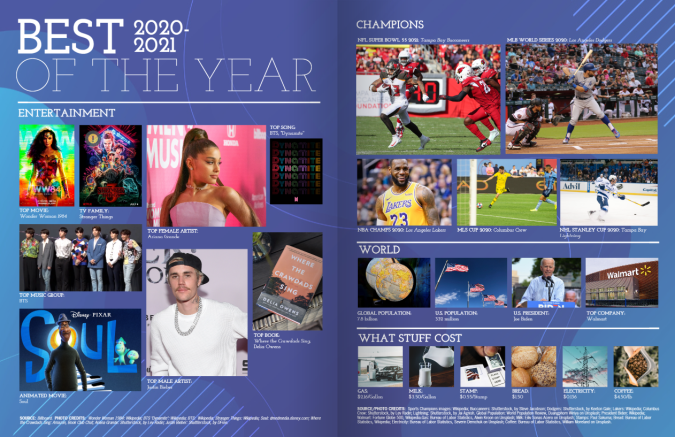
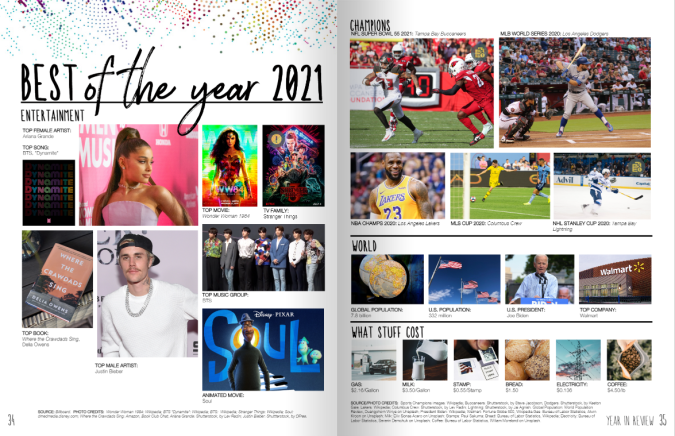
When it comes to including historic events to include in your school’s yearbook, it can be overwhelming about which ones to choose. When considering a year-defining moment, consider the impact it had on your local student body.
Natural disasters are also worth including in your year-end coverage. However, editors must do so while also keeping the sensitivity of the issue in mind. Did your school set up a donation drive to help victims of a tornado or hurricane that devastated another area of the country? Was your campus directly impacted?
Finding a local angle is a technique journalists often use when deciding how they plan to cover a specific event and it’s a tool yearbook editors can use as well. After all, you are a journalist who is documenting each school year!

Fashion trends
Historic moments aren’t the only element that defines a school year. Fashion is another key component that can help illustrate a certain time period as many students use this as an outlet to express themselves. To help determine the latest trends, a great first step is turning to Pinterest or Instagram. From there, have your yearbook staff find students who emulate some of those fads.
You could also assign an Outfit of the Day (#OOTD) photographer to capture students walking into school. Then, in your yearbook, you could feature seasonal styles. (Parents also love to submit these photos, so ask away!)


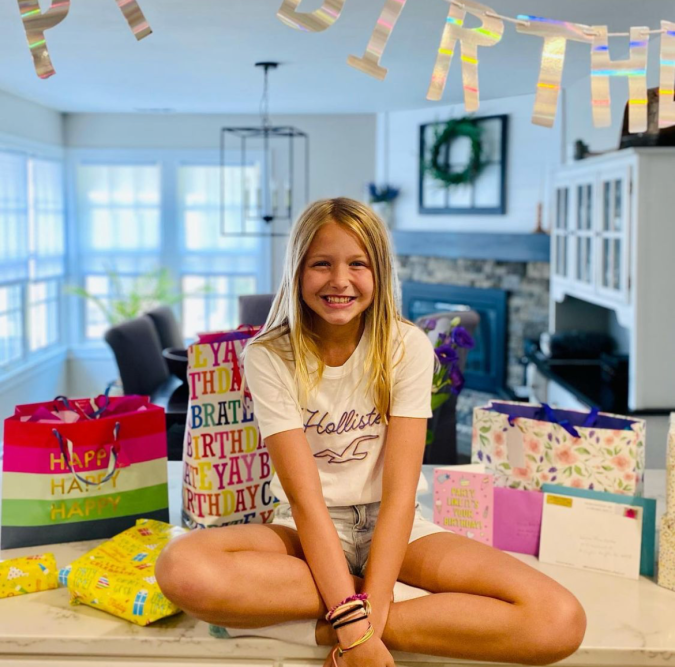
If you do a more traditional fashion spread, be sure to include:
- Mom jeans
- Chunky soled shoes, especially Dr. Martens
- White shoes
- Athletic gear
- Graphic Ts
- The return of the mullet
- Bucket hats (which we hear will be "out" come summer)
- Over-sized sweaters
- 90s style: neon, flannel, wide-legged pants
- Friendship bracelets
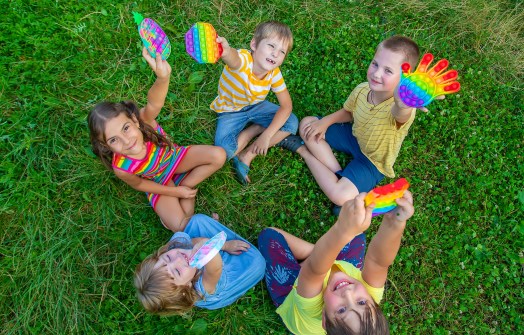
Social media trends
In addition to fashion, you can also consider incorporating social media trends that were popular over the past school year. Who knew TikTok would take off like it did? Remember when customizing your background and picking out songs for your MySpace page was all the rage? We do! Be sure to include some of the dances, trends, or popular songs students may be using on their own TikTok pages.
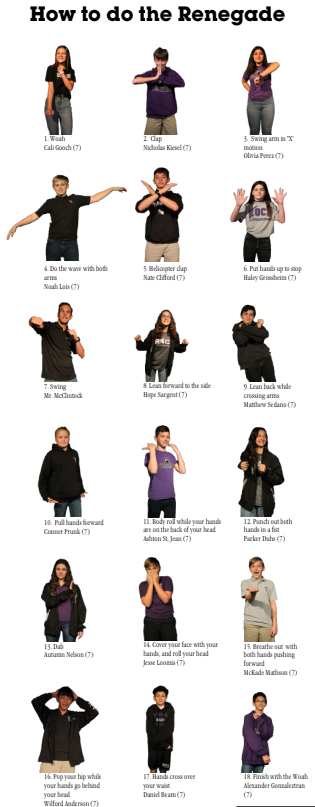
Students will love looking back at these memories 10 years from now, and their kids will love it even more!

Including a diverse set of holidays and celebrations in the yearbook
It all started with a yurt. A mom on campus posted a photo of her daughters in front of their temporary home in a field. As a part of their Sukkot observance, they lived, ate, and gave thanks in the yurt for nearly a week. After asking around, three other families on campus celebrated similarly. This sparked something in our yearbook program: who else lives a life about which we know little? (Answer: everyone!) And this became the catalyst to broadening the scope of our off-campus student life coverage. Read on for tips on inclusive coverage for diverse holidays and celebrations that reflect the individuals in your halls.
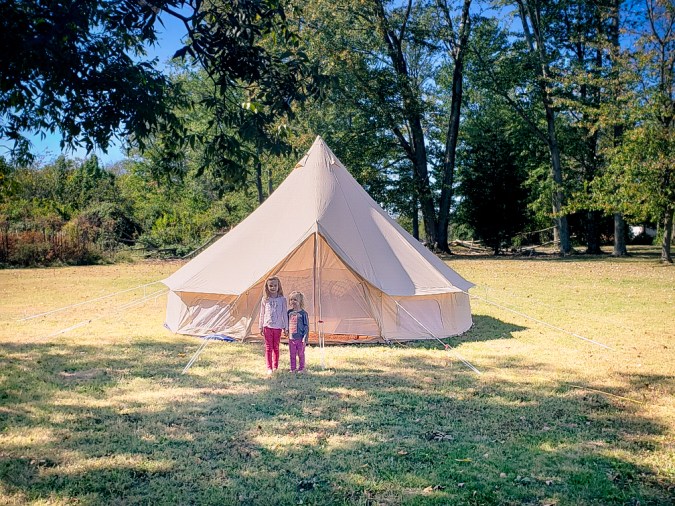
Make Celebrations Individualized
When we work with our students to learn from one another, we model and facilitate courageous conversations. Many of us parents grew up with the adage: politics and religion never make for polite conversation. By focusing your interviews on the individual—versus the religious or cultural practice—you will see it through his/her eyes.
That said, it is never one student’s job to be the “ambassador” for their faith or home country. That’s why we prepared this list of questions to focus on the individual’s celebration. (Just think about how even members of your extended family celebrate birthdays differently!) The narrative that will unfold is about the student or staff member rather than a book report on the celebration. Avoid comparing or contrasting.
- What does [celebration] mean to you?
- What traditions does your family have?
- What food do you eat on [celebration]? What ingredients make it special?
- How do you prepare for [celebration]?
- What music makes it special for you? Why?
Diverse Covergage Ideas
Symbols spreads
Ideally, you’d have photographs of the decor that surrounds your students during the season. If that isn’t possible, use some stock images and position pull quotes of students describing how they use them.
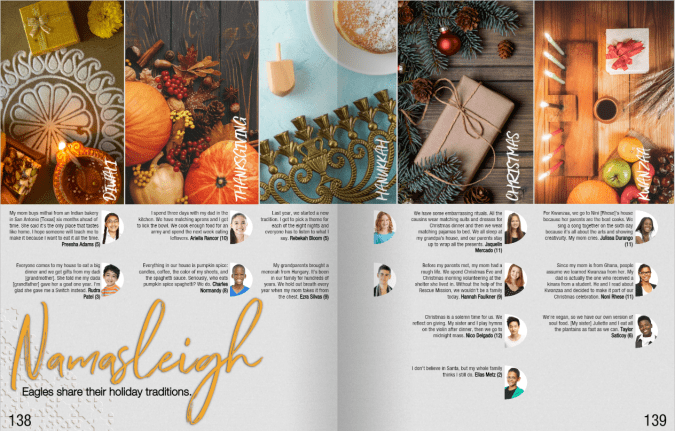
Mini-Modules
Re-enactments of major events, such as Eid, that happen at a student’s place of worship can focus on the process, such as the challenges of memorizing lines or balancing rehearsals with school work. Lunar New Year festivals are another area to cover. Ask students about music, food, and decorations.
Winter or Spring “specials”
Plan ahead for one of the holiday seasons by interviewing students about their celebrations using the questions above.
Spring hosts Easter, Holi, Passover, Ramadan, and Vesak. Fall and winter are the seasons for Bodhi Day, Christmas, Diwali, Kwanzaa, Hanukkah, and Thanksgiving. (Please note, these are in alphabetical order, by season, not chronological as some days change because they are on a lunar calendar, not our American solar calendar.)
Research First
There’s an iconic episode from The Office, “Diwali” that gives us a picture of what could go wrong (and oh-so-right). In typical Michael Scott fashion, he fills a meeting with inaccuracy, and his actions and lack of truth impact those around him. Moral of the story: be Dwight.
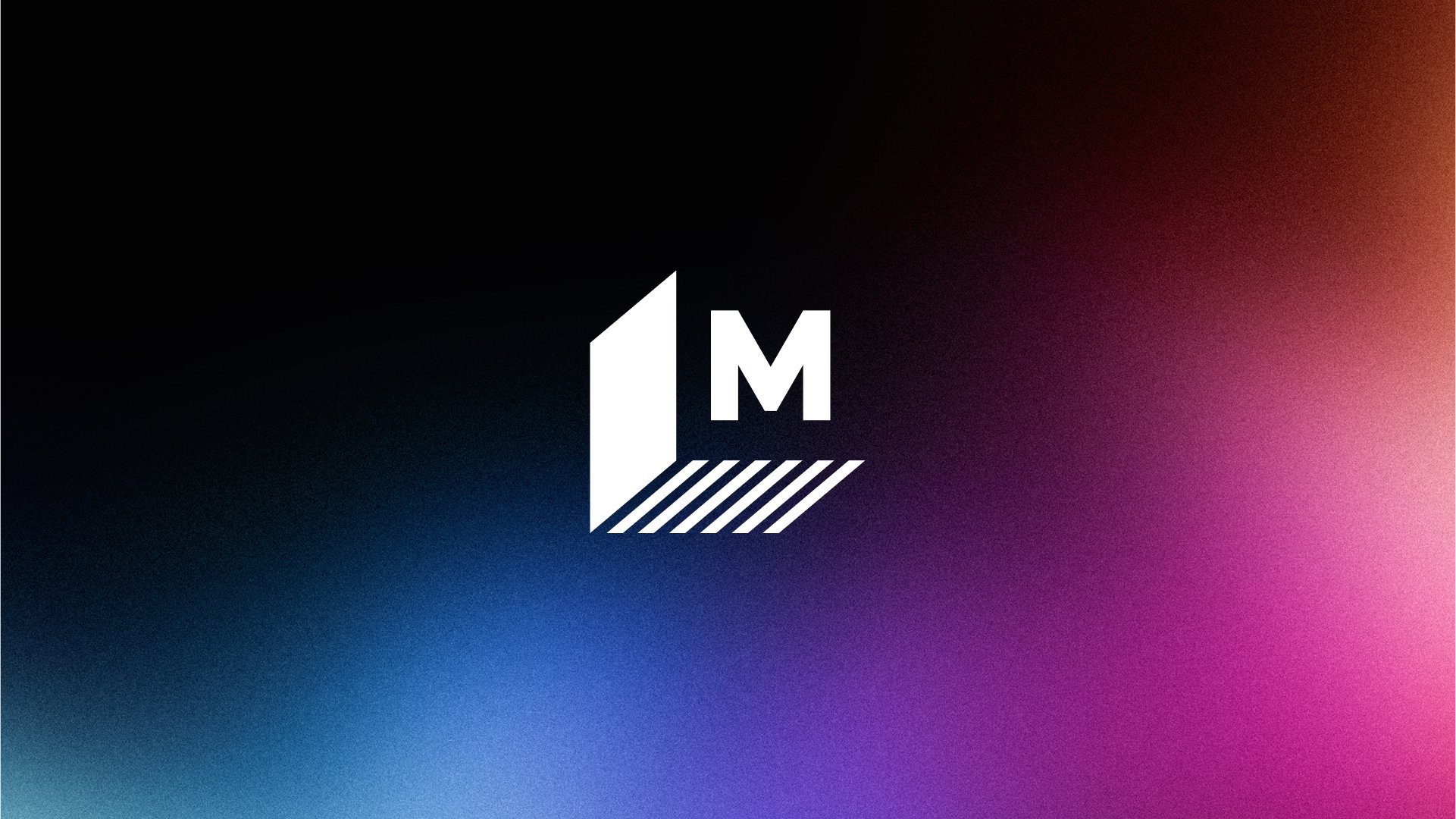
As you prepare to extend coverage to include diverse holidays and celebrations, do a brief study of the symbols and history of the event. These are great classroom opportunities to brainstorm questions and talking points. You can even give a few non-examples to help students filter.
We’ll leave you with this bonus fact: Cinco de Mayo is not Mexican Independence Day. It’s not even a national holiday in Mexico.

2021-2022 yearbook theme trends
UPDATE: see 2023-2024 yearbook theme ideas. For more post-pandemic design trends, keep reading.
Using nostalgic designs, organic colors, and handmade elements, check out how you can harness the design and color trends for your 2021-2022 year(book) themes. The design world is unanimous: joy is back!
Treering has pre-released 15 new on-trend yearbook themes for 2021-2022! Log in to the app (for free) to see the full line of backgrounds, fonts, layouts, and artwork included in each theme to find some inspiration for your yearbook this year. Whether you're a Treering user or not, you can always look and use our ideas no matter who is your yearbook provider.
Trending Now: New Yearbook Theme Sneak Peek
Check back in late August for the full collection of new themes joining the Treering catalog. In the meantime, check out our top on-trend themes below.
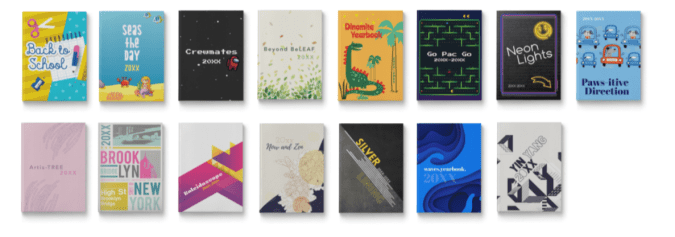
Our Top Five Yearbook Themes and Trends
2022 Yearbook Theme Design Trend: Nostalgia, Color
Nostalgic design is synonymous with retro and vintage with the caveat it evokes emotion. Research shows pieces from the past produce positivity in the present! Pair nostalgic elements such as colors, fonts, and images with old school photos from past yearbooks for a complete blast from the past.
Get the look with Treering:
The 90s are back and with it memories of Lisa Frank binders, Zack Morris phones, and NSYNC songs. As you rock your acid wash jeans and baby doll Ts, check out the vibrant colors and iconic graphics in the Back to School yearbook theme that have as much pop as your fav boy band. Outdoorsy colors—think sunshine, spring water, and wildflowers—brighten up this design with drag-and-drop school supply artwork and backgrounds.
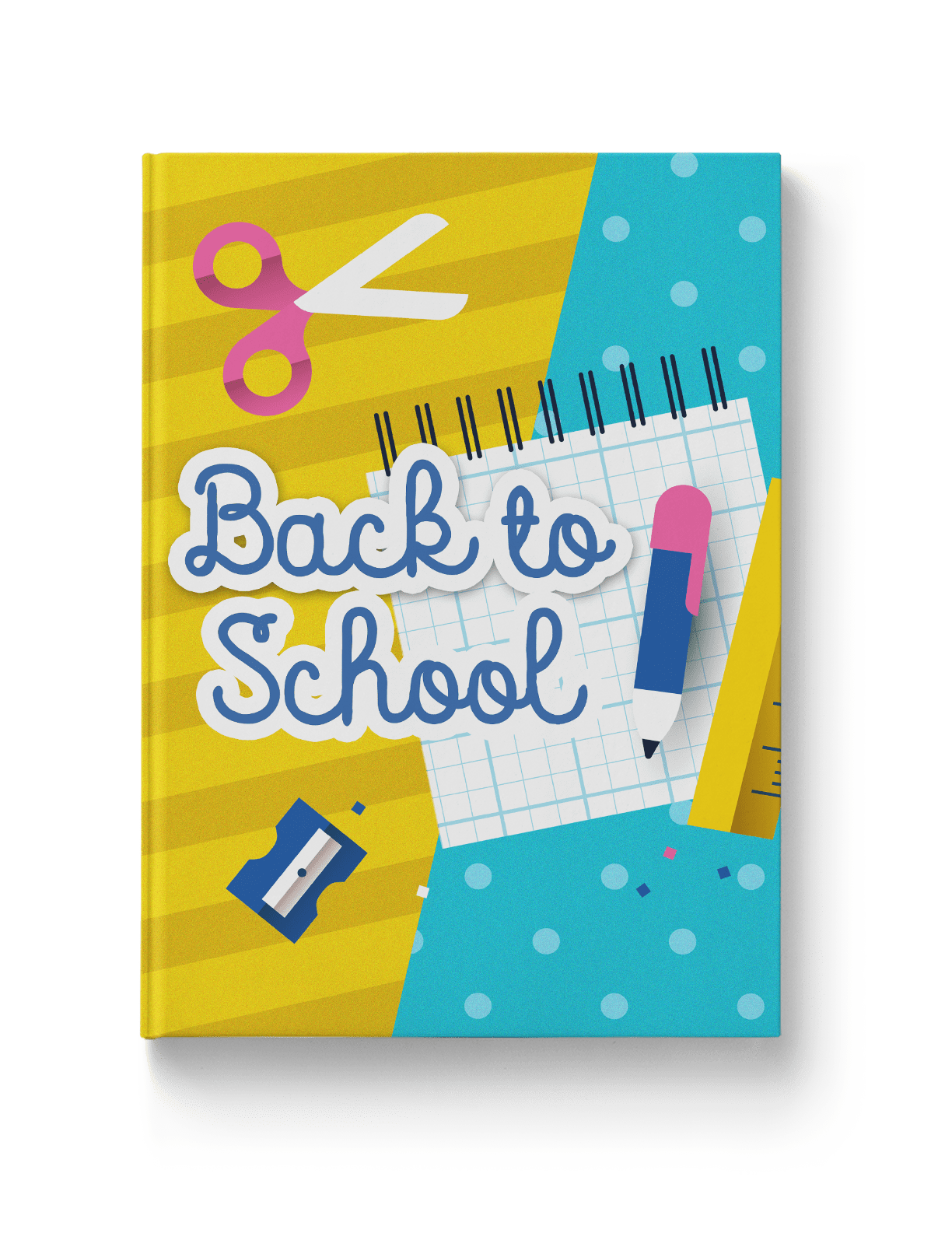
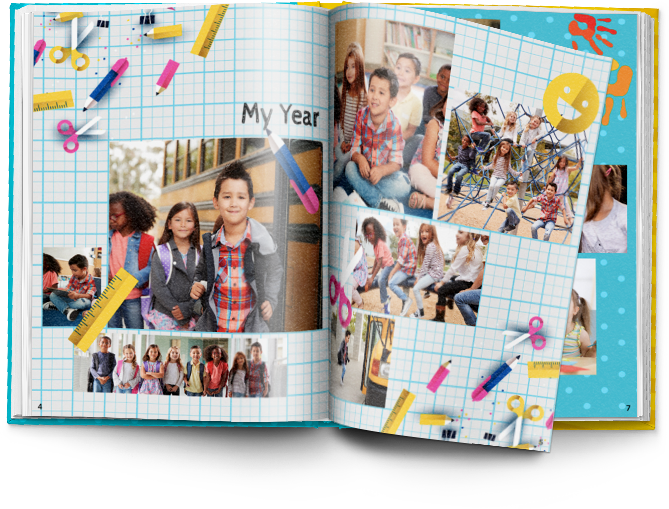
2022 Yearbook Theme Design Trend: Organic, Illustrative Design
In a year when we’re going back-to-basics in the classroom, you can bring them into the yearbook room. Celebrating living things is a tenet of organic design. Flora and fauna pop up in many of the new themes for 2021-2022 (hint, hint).
Hand-drawn images and line art continue to dominate the illustrative graphic design trends. Outlines, line art textures, and freeform shapes get their inspiration from the natural world.
Get the look with Treering:
Now and Zen is an airy collection of crisp lines, layers, geometric shapes set in this yearbook theme's neutral color palette. Like flannel, this design trend is meant to be layered.
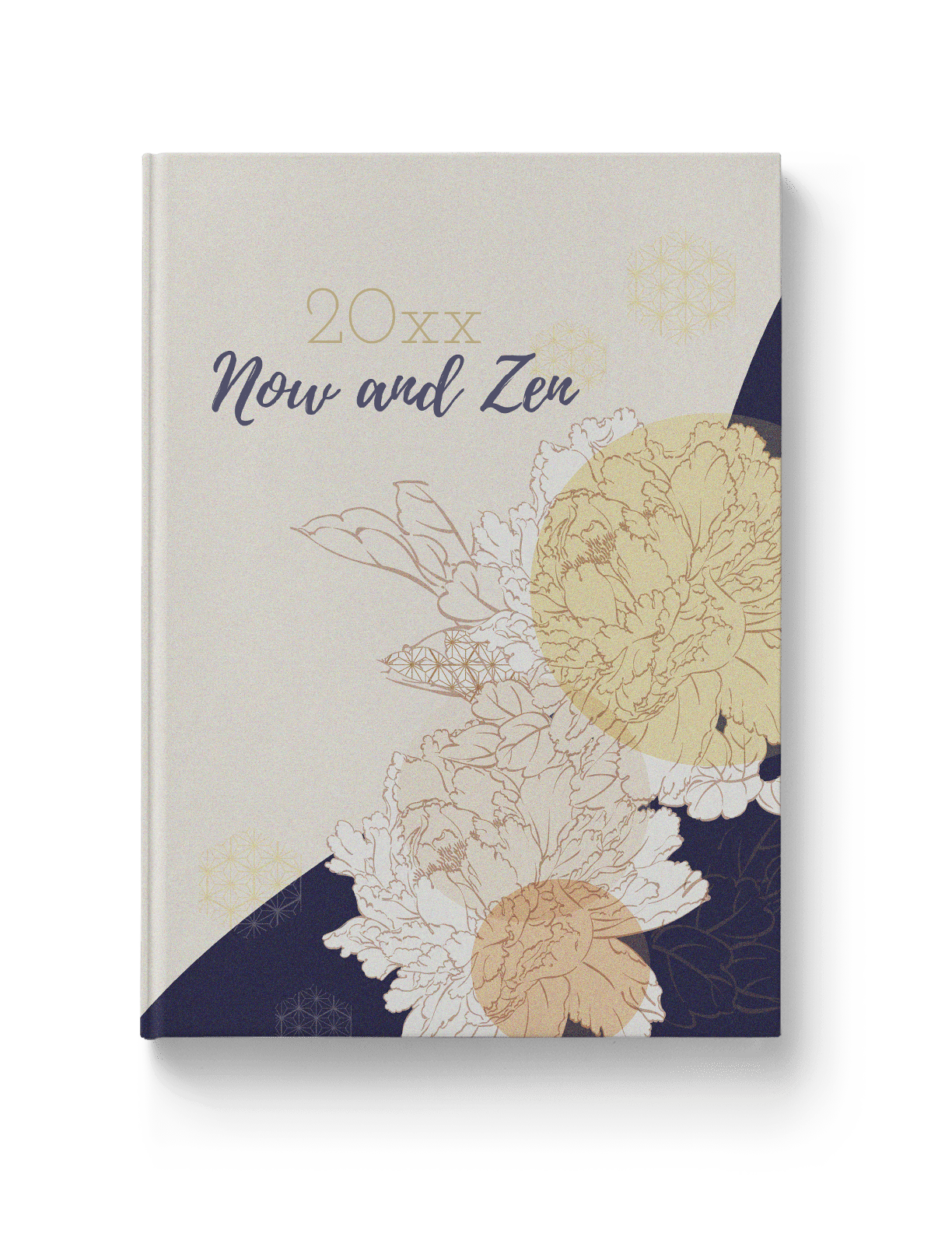

2022 Yearbook Theme Design Trend: Nostalgia, Symbols
We’ve established nostalgia gives us all the feels. Neon’s century-long presence in the US conjures memories from riding in classic cars and drinking malts with grandparents to wearing Electric Youth perfume and sweating through skate nights.
Symbols can do the same. A thumbs up or a heart means you’re getting noticed. A border means READ ME! Arrows tell you to keep going because exciting things are forthcoming! And we all have our go-to emoji for wearing our feelings on our screens.
Get the look with Treering
We modernized the look of neon by adding emojis and icons you can use to divide academics, extracurricular, and personality pages. Because of this, Neon Lights is a complete theme package that will lighten the load for your yearbook team.
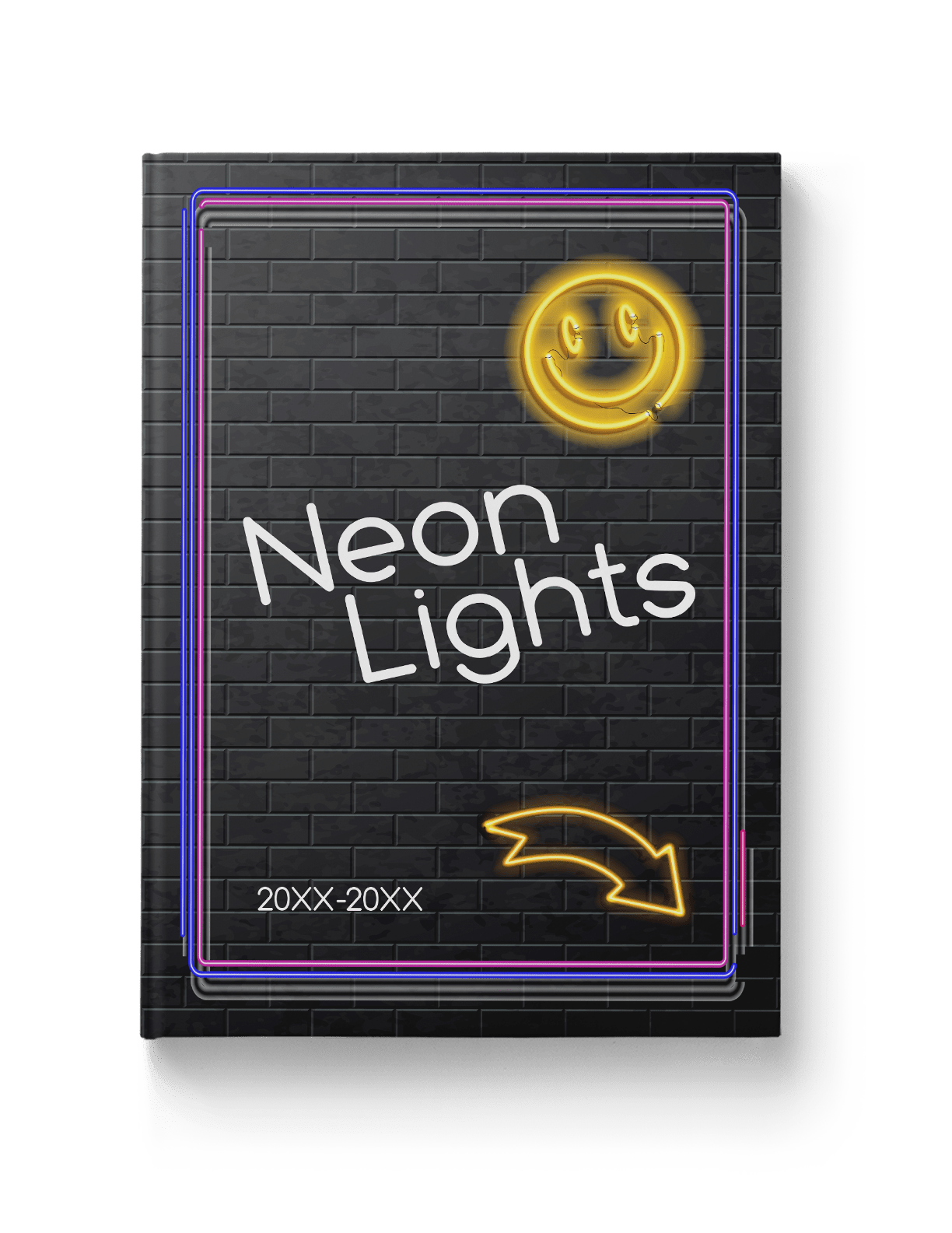
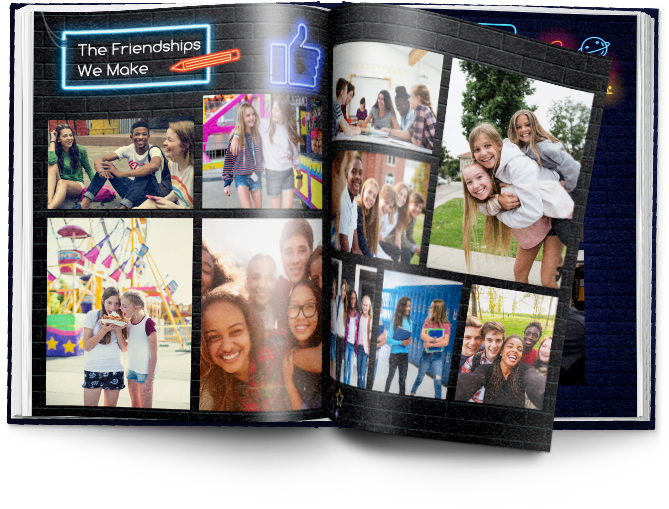
2022 Yearbook Theme Design Trend: Organic, Illustrative Design
After a year inside, the outdoors are calling! Natural textures, shapes, and colors are hot in the interior, industrial, and graphic design. They soothe. While it may not be as sappy as the nostalgic design trend—see what we did there—being in nature boosts creativity and reduces stress. And we need those two things for a budding yearbook program!
Get the look with Treering
The Beyond BeLEAF yearbook theme has illustrative, organic shapes and neutral colors that echo Treering’s commitment to sustainable business practices (shameless plug, I know...). Leafy borders, overlays, and frames hug your photos.

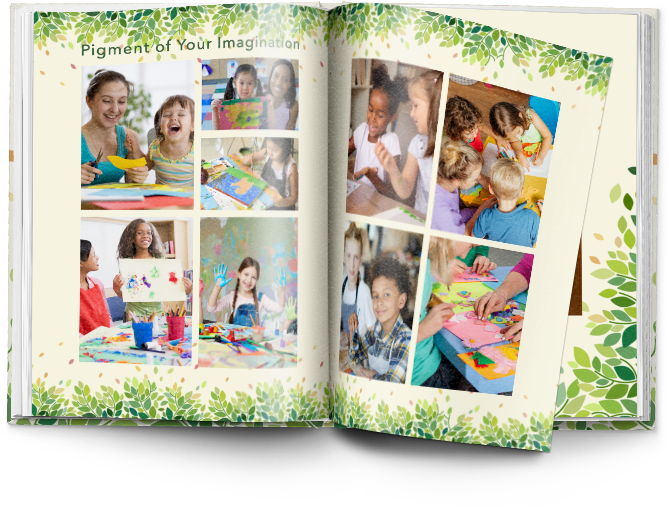
2022 Yearbook Theme Design Trend: Illustrative Design
The glory of illustrative design is its many manifestations: cartoon illustration picks up where the seriousness of the line art design trend leaves off. It’s whimsical and potentially nostalgic. It’s bold and bright. It’s fun and funky. If a playful yearbook theme aligns with your team’s vision, this is the trend to implement!
Get the look with Treering
By taking inspiration from popular games (that’s plural for a reason, people!), we created options for those who want their book to be timely, on-trend, and totally relatable to tweens. Start with the Crewmates theme, then Level Up.
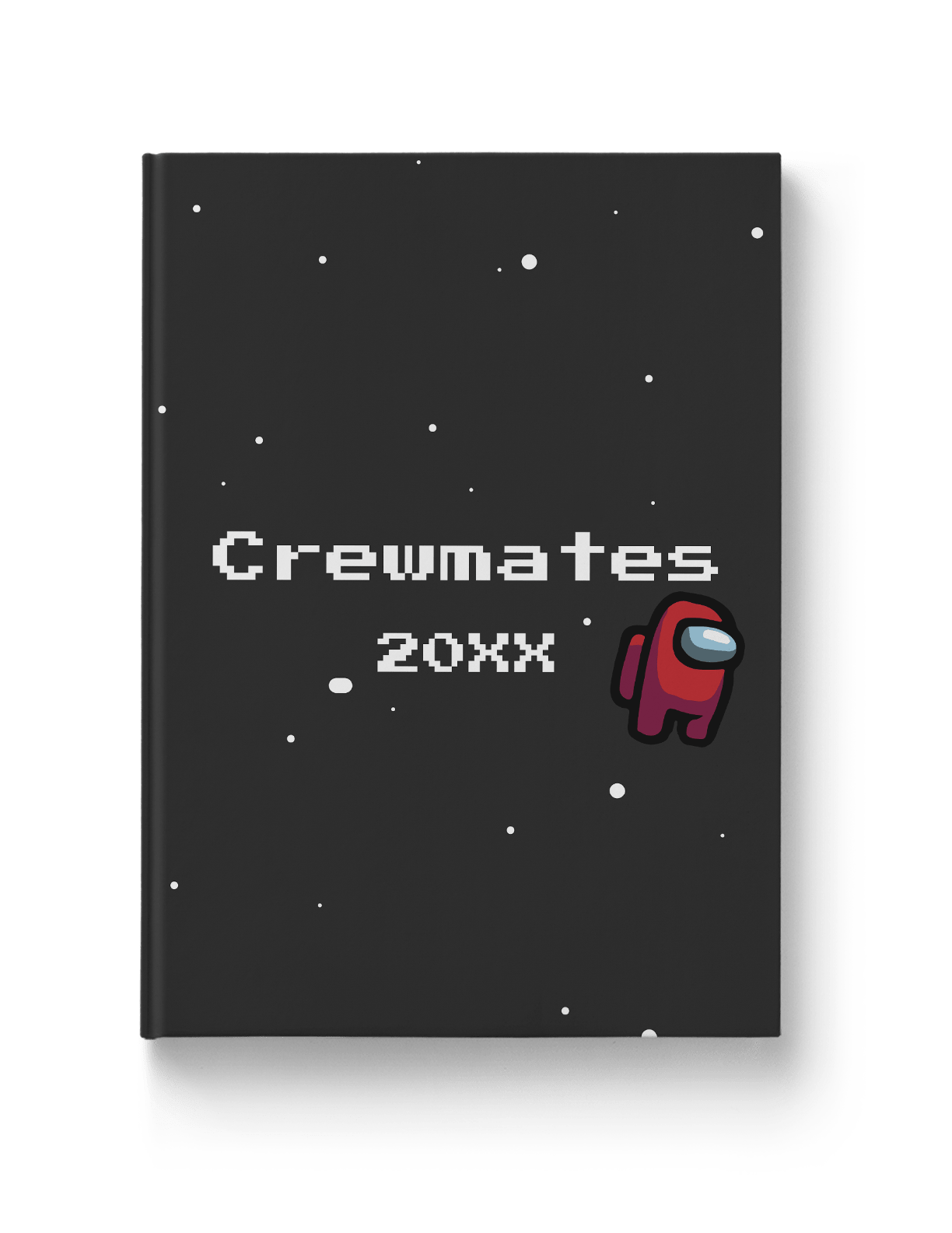
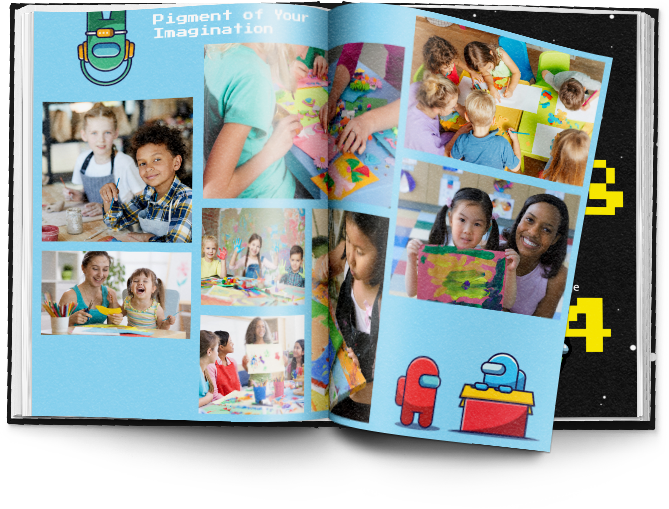
If you'd like more help selecting a yearbook theme and design trend for your community this year, check out these five questions to ask your yearbook team.

Your throwback yearbook theme needs this laser photo background
A Brief History on the Laser Photo Background
The laser photo background was all the rage in the 1980s, when many school portraits featured backdrops crisscrossed with bright, glowing lights. Back then it was totally stylish—and not at all ironic. The fad faded (or fizzled, if you will) and was banished to old yearbooks and family photo albums until 2007. That’s when a blogger posted this photo, titled “Me in ‘91”. It was, up to that point, the first laser photo background on the blog, which described itself as being dedicated to “the celebration of the perfect portrait.” (There is, in case you’re wondering, some sarcasm involved there.) Pretty much everybody sharing the image and basking in its cheesy glory essentially made that single portrait a meme before memes were even popular. The following year, a Tumblr blog called “We have Lasers!” debuted and—yup, you guessed it—it was dedicated entirely to school portraits with a laser photo background. As Lindsey Weber, the blog’s creator wrote in it’s “About” section: “You begged your mom to pay the extra $4. A tribute to the greatest school photo backdrop there ever was.” To say “We have Lasers!” took off would be an understatement: People submitted more than 500 portraits to be featured on the blog in less than two years, and the blog was featured on NPR, CNN, Time, and CBS News. Quickly, laser photo backgrounds went from meme to viral to mainstream. Popular sites, such as Awkward Family Photos and BuzzFeed, began featuring compilations of people posed in front of the iconic background. Even celebrities began recreating laser photo background images as spoofs (re: this picture of former 98 Degrees frontman, Nick Lachey). The Internet was, and in a lot of ways still is, in a laser-photo frenzy. So, how do you pull this trend into your throwback yearbook theme?Where to Find—And How To Use—Laser Photo Backgrounds in Your Throwback Yearbook Theme
There are two places to find laser photo backgrounds:- Buy an actual laser photo backdrop, in the form of a poster, online at Zazzle.com.
- Use this free laser photo background, created by Emily Coxe.
- Choose your image. A picture with a plain background is easiest to work with, so—if you have control over this—have your subject stand in front of a plain wall or against the side of a building to capture some natural light.
- Mask it. In Photoshop, use the pen tool to mask the person in the image. (Learn more about masking here.) You can also use more sophisticated Photoshop techniques, depending on how precise you want the image to appear. If you’re new to Photoshop, however, we recommend sticking to the basics.
- Insert the background. Drag and drop, or copy and paste, the laser background of your choice. Size and position, save your image, and you’re good to go.
- Add your image to a PowerPoint slide. Again, a picture with a plain background is easiest to work with.
- Use the “Remove Background” feature. When you upload a photo in PowerPoint, your toolbar should automatically reset to display the “Format Picture” options that are available. You’ll want to be on that section of the toolbar, so make sure you’re there. Then, under the “Adjust” settings, choose “Remove Background.” PowerPoint guides you through the process from there, and it’s super simple.
- Insert the background. Once you upload the background, you’ll want to size it appropriately and position it, like you did in Photoshop. Make sure you adjust your layers, so that the background is in the back. You can do that by finding the “Arrange” section in the “Format Picture” toolbar, and using the “Reorder” feature.
- Save your image, but be sure to save your image as a .png, .jpg, or .gif file, and not a PowerPoint file.